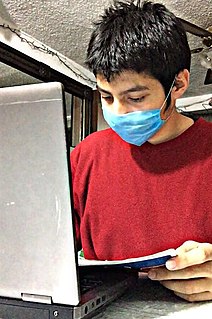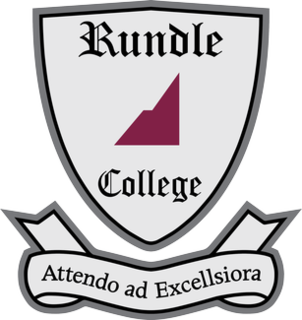
Distance education, also called distance learning, is the education of students who may not always be physically present at a school. Traditionally, this usually involved correspondence courses wherein the student corresponded with the school via mail. Today, it involves online education. A distance learning program can be completely distance learning, or a combination of distance learning and traditional classroom instruction. Massive open online courses (MOOCs), offering large-scale interactive participation and open access through the World Wide Web or other network technologies, are recent educational modes in distance education. A number of other terms are used roughly synonymously with distance education.

Education in Canada is for the most part provided publicly, and is funded and overseen by provincial, territorial and local governments. Education is within provincial jurisdiction and the curriculum is overseen by the province. Education in Canada is generally divided into primary education, followed by secondary education and post-secondary. Within the provinces under the ministry of education, there are district school boards administering the educational programs.
Educational software is a term used for any computer software which is made for an educational purpose. It encompasses different ranges from language learning software to classroom management software to reference software, etc. The purpose of all this software is to make some part of education more effective and efficient.
Education in Japan is compulsory at the elementary and lower secondary levels. Most students attend public schools through the lower secondary level, but private education is popular at the upper secondary and university levels. Education prior to elementary school is provided at kindergartens and day-care centers. The programmes for those children aged 3–5 resemble those at kindergartens. The educational approach at kindergartens varies greatly from unstructured environments that emphasize play to highly structured environments that are focused on having the child pass the entrance exam at a private elementary school. The academic year starts from April and ends in March, having summer vacation in August and winter vacation in the end of December to the beginning of January.
Blended learning is an approach to education that combines online educational materials and opportunities for interaction online with traditional place-based classroom methods. It requires the physical presence of both teacher and student, with some elements of student control over time, place, path, or pace. While students still attend "brick-and-mortar" schools with a teacher present, face-to-face classroom practices are combined with computer-mediated activities regarding content and delivery. Blended learning is also used in professional development and training settings.

Manchester Community College (MCC) is a public community college in Manchester, Connecticut. Founded in 1963, it is the third-oldest of the twelve community colleges governed by the Connecticut State Colleges & Universities system (CSCU) and has graduated more than 23,000 students since the first class in 1965.

An online school teaches students entirely or primarily online or through the Internet. It has been defined as "education that uses one or more technologies to deliver instruction to students who are separated from the instructor and to support regular and substantive interaction between the students. Online education exists all around the world and is used for all levels of education. This type of learning enables the individuals to earn transferable credits, take recognized examinations, or advance to the next level of education over the Internet.
Educational technology is the combined use of computer hardware, software, and educational theory and practice to facilitate learning. When referred to with its abbreviation, EdTech, it is often referring to the industry of companies that create educational technology.

Located in Worcester, Massachusetts, the Massachusetts Academy of Math and Science at WPI was founded in 1992 by the Massachusetts State Legislature as a public, non-residential magnet school to serve academically advanced youth in grades eleven and twelve in math, science, and technology.

Edmonton Public Schools is the largest public school division in Edmonton, the second largest in Alberta, and the sixth largest in Canada. The division offers a variety of alternative and special needs programs, and many are offered in multiple locations to improve accessibility for students. As a public system, Edmonton Public Schools accepts all students who meet age and residency requirements.
The Master of Education is a master's degree awarded by universities in many countries. This degree in education often includes the following majors: curriculum and instruction, counseling, school psychology, and administration. It is often conferred for educators advancing in their field. Similar degrees include the Master of Arts in Education and the Master of Science in Education.
In education, response to intervention is an approach to academic intervention used in the United States to provide early, systematic, and appropriately intensive assistance to children who are at risk for or already underperforming as compared to appropriate grade- or age-level standards. RTI seeks to promote academic success through universal screening, early intervention, frequent progress monitoring, and increasingly intensive research-based instruction or interventions for children who continue to have difficulty. RTI is a multileveled approach for aiding students that is adjusted and modified as needed if they are failing.

Rundle College Society is a not for profit organization operating three schools in Calgary, Alberta. Rundle College was founded in 1985 and provides education for approximately 900 students in pre-school through Grade 12. Rundle's classes are small.
A resource room is a separate, remedial classroom in a school where students with educational disabilities, such as specific learning disabilities, are given direct, specialized instruction and academic remediation and assistance with homework and related assignments as individuals or in groups.

Computers in the classroom include any digital technology used to enhance, supplement, or replace a traditional educational curriculum with computer science education. As computers have become more accessible, inexpensive, and powerful, the demand for this technology has increased, leading to more frequent use of computer resources within classes, and a decrease in the student-to-computer ratio within schools.
The Oregon modified high school diploma, also known as the OAR Modified Diploma, is a document that is given to students who have "a documented history of the inability to maintain grade level achievement due to significant learning and instructional barriers...or a documented history of a medical condition that creates a barrier to achievement." It was given following a 2007 Oregon law, and after some misuse was termed "diploma lite" by The Oregonian.
Structural inequality has been identified as the bias that is built into the structure of organizations, institutions, governments, or social networks. Structural inequality occurs when the fabric of organizations, institutions, governments or social networks contains an embedded bias which provides advantages for some members and marginalizes or produces disadvantages for other members. This can involve property rights, status, or unequal access to health care, housing, education and other physical or financial resources or opportunities. Structural inequality is believed to be an embedded part of the culture of the United States due to the history of slavery and the subsequent suppression of equal civil rights of minority races. Structural inequality has been encouraged and maintained in the society of the United States through structured institutions such as the public school system with the goal of maintaining the existing structure of wealth, employment opportunities, and social standing of the races by keeping minority students from high academic achievement in high school and college as well as in the workforce of the country. In the attempt to equalize allocation of state funding, policymakers evaluate the elements of disparity to determine an equalization of funding throughout school districts.p.(14)

A flipped classroom is an instructional strategy and a type of blended learning, which aims to increase student engagement and learning by having students complete readings at their home and work on live problem-solving during class time.

The term learning environment can refer to an educational approach, cultural context, or physical setting in which teaching and learning occur. The term is commonly used as a more definitive alternative to "classroom", but it typically refers to the context of educational philosophy or knowledge experienced by the student and may also encompass a variety of learning cultures—its presiding ethos and characteristics, how individuals interact, governing structures, and philosophy. In a societal sense, learning environment may refer to the culture of the population it serves and of their location. Learning environments are highly diverse in use, learning styles, organization, and educational institution. The culture and context of a place or organization includes such factors as a way of thinking, behaving, or working, also known as organizational culture. For a learning environment such as an educational institution, it also includes such factors as operational characteristics of the instructors, instructional group, or institution; the philosophy or knowledge experienced by the student and may also encompass a variety of learning cultures—its presiding ethos and characteristics, how individuals interact, governing structures, and philosophy in learning styles and pedagogies used; and the societal culture of where the learning is occurring. Although physical environments do not determine educational activities, there is evidence of a relationship between school settings and the activities that take place there.

Learning space or learning setting refers to a physical setting for a learning environment, a place in which teaching and learning occur. The term is commonly used as a more definitive alternative to "classroom," but it may also refer to an indoor or outdoor location, either actual or virtual. Learning spaces are highly diverse in use, learning styles, configuration, location, and educational institution. They support a variety of pedagogies, including quiet study, passive or active learning, kinesthetic or physical learning, vocational learning, experiential learning, and others.









